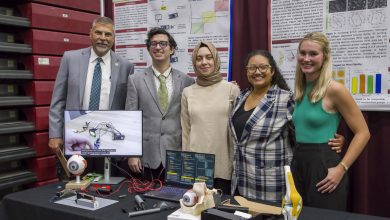Students design and build UAV to assist NASA Mars Rover
Four seniors in aerospace engineering decided that their final project would be to design an unmanned aerial vehicle (UAV) that could provide aerial assistance to a potential NASA Mars Rover, specifically by delivering tools and providing surveillance.
NASA Mars Rover
Each year, the Mars Society organizes the University Rover Challenge in which teams from all over the world are selected to design and build a next generation Mars Rover system that could eventually assist astronaut exploration on the planet.
The Inspiration
Like his classmates, team member Isaac Spence had always been fascinated with space systems and was very excited for the project. He hopes to work on space systems after graduation, so participating in URC was a no-brainer.
Most senior design projects are carried over from year to year to build upon learned experiences and concepts so students can continue to make improvements. Isaac and his teammates were the first Florida Tech team to enter the competition however, so they had a lot of creative license.
The Struggle
One of the biggest problems for a project of this size was interfacing between all of the different subgroups. Overall, there were four different subgroups for the project: UAV, Rover, Arm, and Controls.
According to Isaac, maintaining communication between the groups and making sure all of the final products would work in unison for competition was a constant challenge.
“For the UAV in particular, one of the challenges was overcoming the necessary deadweight given by the competition rules,” he said. “In order to simulate flight on Mars, competition requires the UAV to keep deadweight equal to the battery weight. This requires much more power to compensate for the increased weight of the system in order to keep flight time.”
Challenges aside, Isaac is amazed by what four engineering students were capable of creating in only a year. Being a member of the Florida Tech basketball team, he has struggled with finding time for coursework, but he and his team were able to put together an award winning product. This is what he is most proud of.
To Do Differently
Brock Hedlund, another member of the team, believes it would have been more ideal if manufacturing and testing had begun earlier.
“Fortunately, we were able to manufacture the vehicle in an efficient and timely manner and arrived at the showcase with a complete product,” he said, “but many teams were scrambling to finish on time. Starting our manufacturing process earlier would have given us the chance to fully test and make refinements before the showcase.”
The Future
“Overall, this senior design project provided a great experience working in an engineering team environment,” Brock said. “We learned the fundamentals of design, analysis, and problem solving.”
The team also gained considerable real-world experience in planning for deadlines and budgeting. “In order to keep both costs and weight low for the vehicle, we made almost all of the carbon fiber parts ourselves, which served as great firsthand experience in a field where carbon composites are a superlative material,” Brock explained.
His advice to future senior design presenters is to “find a project that really excites and inspires you to push the boundaries of engineering technology.”





